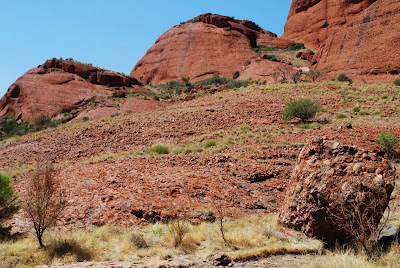The Great Barrier Reef is no doubt the most well-known attraction in Cairns, but the list of stuff to do and see goes so much longer: beautiful camping "where the rainforest meets the reef" in Cape Tribulation, exceptional wildlife zoos and sanctuaries, forests with lakes and waterfalls, hiking, bunjy jumping, skydiving, hang gliding, mountain biking, fishing, sailing, parasailing, abseiling, all kinds of atv activities, whitewater rafting, horseback riding, and people who actually dance.
 |
| The surprisingly dangerous cassowary |
 |
| Shops and cafes along the esplanade, which travels along the oceanside walkway |
 |
| Great Barrier Reef diving |
 |
| The Daintree Rainforest |
Cairns is the tourism capital of Australia, and that's pretty obvious, but the town is small and feels closer to Santa Cruz than Miami. It's not overwhelming, but there's a good amount of hippie culture here . In the outback my tour guides were rough around the edges - here my guide through the Daintree rainforest played Hare Krishna music on the bus and "quizzed" us on facts with directed answers ("When was Australia first discovered? 60,000 years ago! *Ding*, correct!"). People here are laid back and spend a lot of time in beachwear despite there being no true beach (only a man-made "lagoon" - remember: crocodiles).
A favorite Cairns moment of mine was seeing some guy in the grocery store (in a mall, no less) in nothing but a bathing suit. No shoes, no shirt, no service is pretty standard, so I took a second look - it was one of my dive instructors :P
It's one of the few places where, after having left, I wish I would have bought a tourist shirt. Because I do "heart" Cairns.
 |
| Camper van |
 |
| Cape Tribulation |
Not to mention it's gorgeous.
In short, I'm left wishing it were somehow a part of the US so I could make regular trips.
Tours I took in Cairns:
-Atherton tablelands waterfall and lake tour with Uncle Brian's. Takes you as far as 2 hours outside of Cairns into the forest and then the rolling countryside. The wit on this tour was unforgettable.
-Cape Tribulation and wildlife park tour north of Cairns into the Cape so-named after Captain Cook totaled his ship on the reef. Very, very beautiful rainforest and nice, quiet stay in a cabin for a night. No swimming - again, crocodiles - but beautiful hiking and pretty located on the beach.
-"Learn to Dive" 5 day course, 3 day live aboard on the Great Barrier Reef with Pro Dive Cairns. Absolutely perfect - gorgeous reef, nice boat, great food, great people - and now I'm PADI certified for any future adventures :)
-Bunjy Jumping at the AJ Hackett tower- one of few purpose-built bungy jumping facilities in the world. I never intended to go bunjy jumping, so why here? 100% safety rating and 15 years in operation, that's why. And probably the best move towards conquering a fear of heights.
A message to you, domestically untraveled Aussies: you're seriously missing out if you've never been here. Get on it!
 |
| Scuba Zen |
Videos of my time in Cairns: (via my YouTube channel, MeChamaCisne)
General Scuba on the Barrier Reef: http://www.youtube.com/watch?v=3UDHVn4PxU0
Playing with a giant fish: http://www.youtube.com/watch?v=Z0ZfRElE7gY
Reef Shark: http://www.youtube.com/watch?v=Wc1SthZQSXU
Giant Clam: http://www.youtube.com/watch?v=SSY3xg8yIc4
Bunjy Jump: http://www.youtube.com/watch?v=B7jbaQHjg8Y
More fun with Aussie sayings:
There are a few sayings in the northern parts which I never heard much, if at all, while in Sydney:
"Mufti days" - casual dress days. Used for both work and private school.
"Pommes" - possibly derogatory word for the Brittish - usually ex-pats. An Aussie told me this term was short for "pomegranates" - the color that Brits come after coming here and being out in the sun. A Brittish person told me that no, this was derived from some old reference to the Brittish ships bringing over potatoes, which are "pommes" in French. Hmmmmmm.
"Bugger that" - As in, "Take the bus for 12 hours? Nah, bugger that, take a plane!"
"Ripper" - pronounced "Rippaaa." As in, "Everybody on the bus? Rippaa!"
















